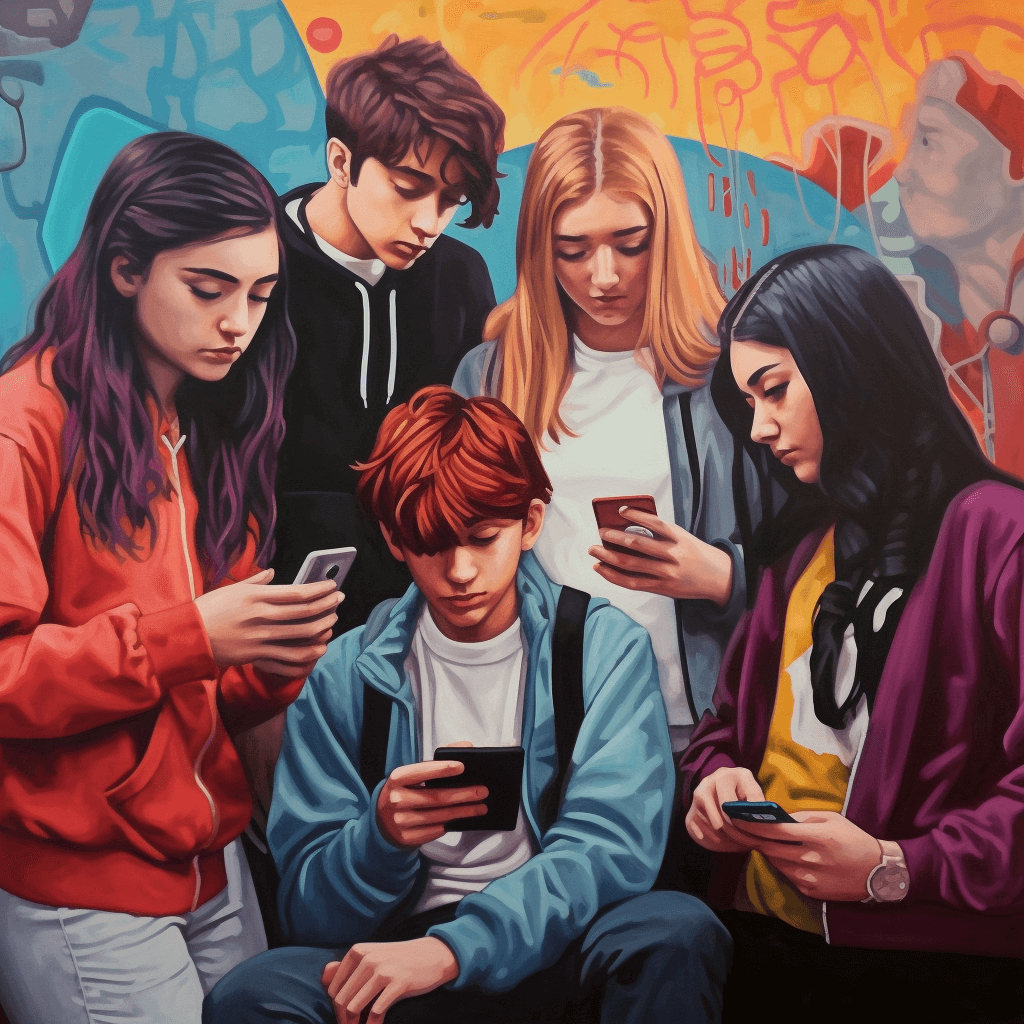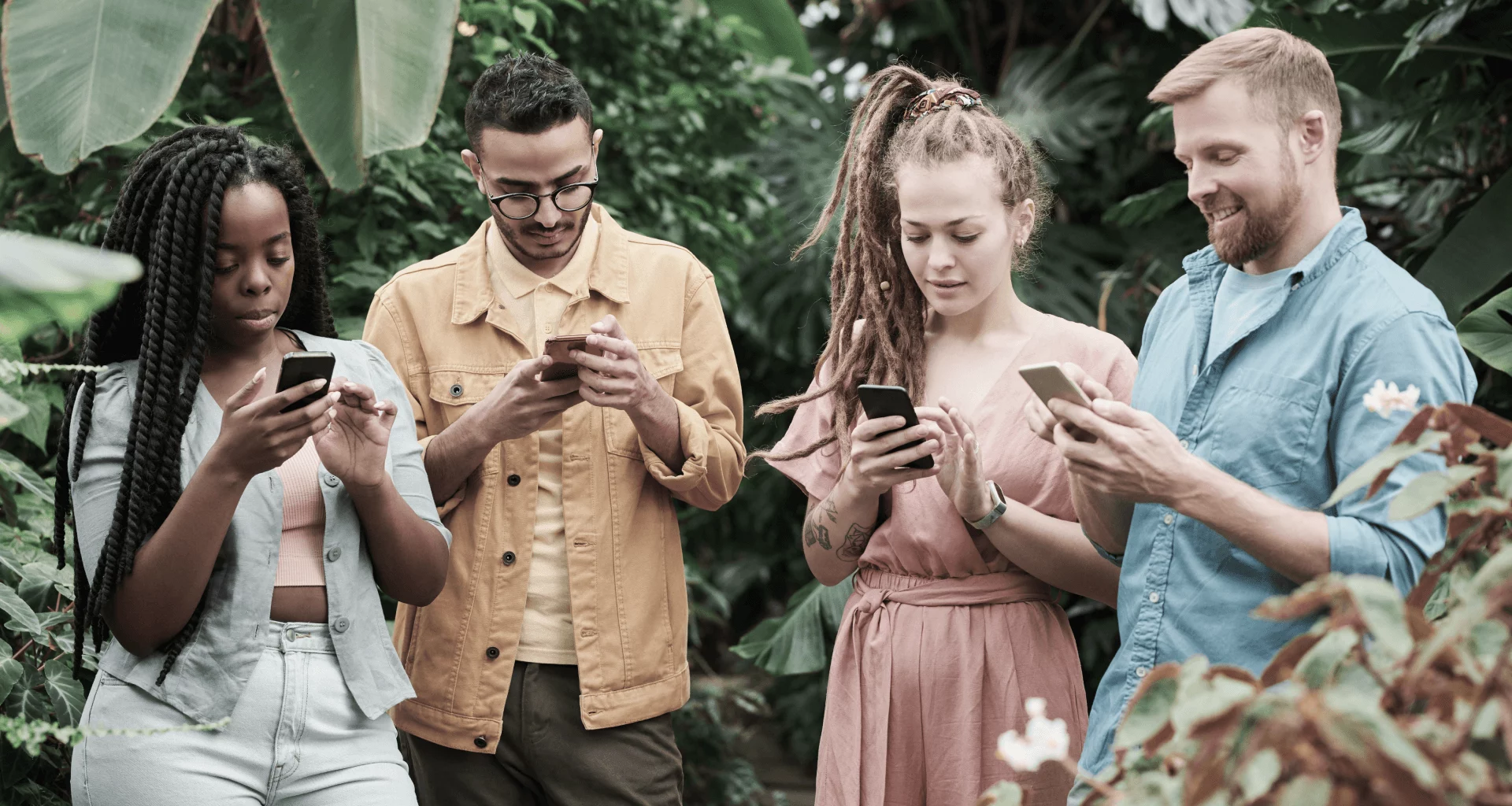In our digital age, the landscape of communication, entertainment, and information has been transformed dramatically, with social media at the forefront of this revolution. A staggering 97% of teenagers use social media, making it a potent force in shaping their worldviews, attitudes, and behaviors. As such, understanding the effects of social media usage on this age group is both a necessary and pressing concern.
Here, we will delve into the world of likes, shares, tweets, and snaps, exploring the multifaceted impact of social media on today’s young generation. We aim to dissect both the empowering and the potentially harmful effects of these platforms on teenagers’ mental health, social interactions, self-image, and academic performance. As we navigate through this complex web of digital interactions, we hope to shed light on the ways we can harness the power of social media to enhance positive growth and mitigate its adverse effects among teenagers.
Table of Contents
- Social Media and its impact on adolescent brain development
- Negative Effects of Social Media on Adolescent Brain Development
- The prevalence of cyberbullying on social media platforms and how parents can help their teens cope with it.
- How Parents Can Help Their Teens Cope with Cyberbullying
- How social media usage among teenagers can disrupt sleep patterns and impact their overall health.
- Understanding the importance of privacy and how to teach teenagers to protect their personal information online.
- The impact of social media usage on mental health, including anxiety, depression, and stress.
- Managing the Impact of social media usage on mental health
- How social media usage among teenagers can impact academic performance and how parents can help their teens balance online and offline activities.
- The importance of parental supervision and involvement in their teen’s social media activity.
- How parental involvement can mitigate these risks
- Highlighting the positive aspects of social media and how it can be used to build social connections and community among teenagers.
- Strategies for helping teens develop healthy social media habits and establish boundaries around social media use
- Educate teens about the potential risks of social media use
- Encourage teens to take breaks from social media
- Set limits on social media use
- Model healthy social media use
- Encourage teens to engage in offline activities
- Use social media for positive purposes
- Use parental control tools
- Have open and honest conversations
- Frequently Asked Questions

Social Media and its impact on adolescent brain development
Social media platforms provide adolescents with a wealth of opportunities for personal and social development. Here are some of the ways in which social media can have a positive impact on adolescent brain development:
Enhanced Social Connections
Social media allows adolescents to connect with friends and family from all around the world, which can help improve their social skills and broaden their worldview. A study found that social media usage was positively associated with increased social connectedness, which in turn positively impacted mental health.
Increased Access to Information
Social media platforms provide adolescents with access to a wide range of information, from news updates to educational resources. By using social media to learn about new topics, adolescents can improve their cognitive skills and broaden their knowledge base. A study found that social media usage had a positive impact on information-seeking behaviors in adolescents.
Creative Expression
Social media platforms offer adolescents a platform to express themselves creatively through photography, art, and writing. By sharing their creativity with others, adolescents can build self-esteem and improve their emotional regulation skills. A study found that social media usage positively impacted creativity and self-expression in adolescents
Negative Effects of Social Media on Adolescent Brain Development
While social media has its benefits, excessive use of these platforms can have negative impacts on adolescent brain development.
Here are some of the ways in which social media can negatively impact adolescent brain development:
Decreased Gray Matter Volume
Excessive social media usage can lead to decreased gray matter volume in the amygdala, which is responsible for processing emotional information. A study found that adolescents who spent more time on social media had reduced gray matter volume in the amygdala, which could affect their emotional regulation skills.
Increased Symptoms of Depression and Anxiety
Excessive social media usage could lead to increased symptoms of depression and anxiety in adolescents. A study found that adolescents who used social media platforms more frequently had higher levels of anxiety and depression symptoms than those who used it less frequently.
Decreased Self-esteem and Increased Feelings of Social Isolation
Excessive social media usage could lead to decreased self-esteem and increased feelings of social isolation in adolescents. According to a study, Behavior, and Social Networking found that adolescents who used social media platforms excessively reported feeling more lonely and isolated than those who used it less frequently.
Social media platforms have become an integral part of adolescent life, providing opportunities for social connection, creative expression, and access to information. However, excessive social media usage can have detrimental effects on adolescent brain development, leading to decreased gray matter volume.
The prevalence of cyberbullying on social media platforms and how parents can help their teens cope with it.
The advent of technology and social media platforms has brought a lot of benefits to the world, including ease of communication and access to information. However, it has also led to a significant rise in cyberbullying, which can have devastating effects on teenagers.
Prevalence of Cyberbullying on Social Media Platforms
Cyberbullying is defined as the use of technology to harass, intimidate, or harm others. According to a study, approximately 59% of US teens have experienced some form of cyberbullying
Cyberbullying can take many forms, including:
Harassment
This involves sending threatening or offensive messages to the victim. This can be done anonymously or under a fake identity, which makes it challenging to track down the bully.
Exclusion
This involves intentionally leaving out someone from a group chat or social media platform. Exclusion can lead to feelings of loneliness and isolation, which can have a significant impact on the victim’s mental health.
Spreading Rumors
This involves spreading false or misleading information about someone online. This can be done anonymously or under a fake identity, and it can have a significant impact on the victim’s reputation.
How Parents Can Help Their Teens Cope with Cyberbullying
Encourage Communication
It is important for parents to create an environment where their teens feel comfortable talking about their experiences with cyberbullying. Parents should actively listen and provide support without judgment. According to a study, parental support was found to be a significant predictor of the ability of teenagers to cope with cyberbullying.
Teach Coping Strategies
Parents can help their teens develop coping strategies to deal with cyberbullying. These strategies can include taking a break from social media, blocking the bully, and reporting the incident to the social media platform. A study found that problem-focused coping strategies, such as blocking the bully, were more effective than emotion-focused coping strategies, such as ignoring the bully.
Educate About Online Safety
Parents should educate their teens about online safety and the dangers of sharing personal information online. According to a study, teens who received parental guidance on internet safety were less likely to experience cyberbullying.
Cyberbullying is a prevalent issue on social media platforms, and it can have a significant impact on the mental health and well-being of teenagers. Parents can play an essential role in helping their teens cope with cyberbullying by encouraging communication, teaching coping strategies, and educating them about online safety. By working together, we can create a safer and more positive online environment for teenagers.
How social media usage among teenagers can disrupt sleep patterns and impact their overall health.
Social media platforms have become an integral part of teenagers’ lives. They use social media to connect with friends, share their thoughts and feelings, and stay up-to-date with the latest news and trends. However, excessive use of social media can lead to disrupted sleep patterns, which can have a significant impact on their overall health.
The Impact of Social Media on Sleep Patterns
Blue Light Exposure
The blue light emitted by electronic devices, such as smartphones and tablets, can interfere with the body’s natural production of melatonin, a hormone that regulates sleep. A study found that adolescents who used electronic devices before bedtime had shorter sleep durations and later bedtimes than those who did not.
FOMO (Fear Of Missing Out)
Teens are more likely to experience FOMO when using social media, which can lead to delayed bedtimes and disrupted sleep patterns. A study found that FOMO was positively associated with social media usage and negatively associated with sleep quality
Social Comparison
Social media can create an environment of constant comparison, which can lead to increased anxiety and stress. A study that social media usage was associated with poorer sleep quality, and this association was partially mediated by social comparison.
The Impact of Disrupted Sleep Patterns on Overall Health
Mental Health
Sleep deprivation can lead to increased anxiety, depression, and irritability. A study found that adolescents who had insufficient sleep were more likely to experience symptoms of depression and anxiety.
Physical Health
Sleep deprivation can also lead to physical health problems, such as obesity, diabetes, and cardiovascular disease. A study found that adolescents who had disrupted sleep patterns had a higher risk of developing obesity [5].
Academic Performance
Sleep deprivation can also have a significant impact on academic performance. A study found that adolescents who had insufficient sleep had lower grades and were more likely to be absent from school
Social media usage can disrupt sleep patterns among teens, leading to negative impacts on their overall health. Blue light exposure, FOMO, and social comparison are some of the ways that social media can affect sleep patterns. Disrupted sleep patterns can also lead to mental health problems, physical health problems, and academic difficulties. As parents and educators, it is important to encourage healthy sleep habits and limit social media usage before bedtime to ensure that teens get the restful sleep they need for optimal health and well-being.
Understanding the importance of privacy and how to teach teenagers to protect their personal information online.
Protecting Personal Information
Sharing personal information online can make teens vulnerable to identity theft, cyberbullying, and other forms of online harassment. A study found that adolescents who shared more personal information online were at higher risk for online harassment
Maintaining Personal Safety
Sharing personal information online can also compromise personal safety. Posting information about location or travel plans can make teens vulnerable to stalking and other forms of physical harm. A study found that adolescents who shared more personal information online were more likely to experience offline victimization
Protecting Reputation
Sharing inappropriate content or personal information online can have long-term consequences on teenagers’ reputations. Employers, colleges, and others can access online content and use it to make judgments about individuals. A study found that 84% of employers used social media to recruit candidates, and 43% of employers had decided not to hire a candidate based on their online content.
Educate Teens on the Risks
Teens need to be aware of the potential risks associated with sharing personal information online. Parents and educators can educate teens on these risks and provide guidance on how to protect their personal information. A study found that parental monitoring and supervision were associated with lower levels of online harassment victimization
Encourage Safe Online Behaviors
Teens can take steps to protect their personal information, such as setting privacy settings on social media accounts, using strong passwords, and avoiding sharing personal information online. A study found that parental mediation strategies, such as setting rules about online behavior and monitoring online activity, were associated with safer online behavior among teenagers
Model Safe Online Behaviors
Parents and educators can model safe online behaviors by setting privacy settings on their own social media accounts, using strong passwords, and avoiding sharing personal information online. A study found that parental monitoring and supervision were associated with lower levels of online harassment victimization
Teaching teenagers to protect their personal information online is essential for their safety and well-being. Sharing personal information online can compromise personal safety, and reputation, and increase the risk of identity theft and cyberbullying. Educating teens on the potential risks, encouraging safe online behaviors, and modeling safe online behaviors can help protect their personal information and keep them safe online. As parents and educators, it is our responsibility to ensure that teenagers are equipped with the necessary skills to navigate the digital world safely.
The impact of social media usage on mental health, including anxiety, depression, and stress.
Social media has become an integral part of our daily lives, providing a platform for us to connect with friends, family, and people around the world. While it has its benefits, studies have shown that social media usage can have a negative impact on mental health, leading to increased levels of anxiety, depression, and stress.
Social media usage and anxiety
Research has shown that social media usage associate with increased levels of anxiety. A study found that people who use social media frequently are more likely to experience anxiety and depression than those who use it less often. This may be due to the pressure to present a perfect image of oneself on social media, leading to a fear of missing out (FOMO) and social comparison. People may feel anxious about not living up to the standards set by others, leading to self-doubt and negative feelings.
Social media usage and depression
Social media usage has also a coonection to depression. A study found that social media usage is associated with increased levels of depression, anxiety, and poor sleep. This may be due to negative social comparison and unrealistic portrayals of life on social media. People may feel depressed when they see others living perfect lives, while they may not be doing as well. This can lead to feelings of isolation and sadness.
Social media usage and stress
Social media usage also associates with increased levels of stress. A study found that people who use social media frequently experience higher levels of stress than those who use it less often. This may be due to the constant exposure to information and the pressure to respond to messages immediately. People may feel overwhelmed by the constant need to be connected, leading to increased stress levels.
Managing the Impact of social media usage on mental health
While social media usage can have negative impacts on mental health, there are ways to manage its effects. Here are some tips:
Set limits on social media usage
By setting limits on social media usage, people can reduce the amount of time spent on social media, which may help to reduce feelings of anxiety, depression, and stress.
Use social media mindfully
Mindful social media usage involves being aware of the potential negative effects of social media and being intentional about the content and the people one follows. This may help to reduce negative social comparisons and increase positive interactions.
Take breaks from social media
By taking regular breaks from social media, people can reduce their exposure to negative content and reduce the pressure to constantly be connected.
Seek professional help
If social media usage is causing significant distress, people should seek professional help, such as therapy or counseling. These professionals can provide support and guidance to help people manage the impact of social media usage on mental health.
Social media has become a part of our daily lives, but it can have negative impacts on mental health. Research has shown that social media usageamong teenagers associates with increased levels of anxiety, depression, and stress. However, by setting limits, using social media mindfully, taking breaks, and seeking professional help, people can manage the impact of social media use on mental health. It is important to be aware of the potential negative effects of social media and take steps to manage its impact.
Teaching teenagers to protect their personal information online is essential for their safety and well-being. Sharing personal information online can compromise personal safety, and reputation, and increase the risk of identity theft and cyberbullying.
How social media usage among teenagers can impact academic performance and how parents can help their teens balance online and offline activities.
Social media has revolutionized the way we communicate and share information. With the advent of smartphones and other mobile devices, social media has become more accessible than ever before. However, with increased use of social media, concerns have been raised about its impact on academic performance, particularly among teenagers. here, we will explore the ways social media usage among teenagers can impact academic performance and provide tips for parents on how to help their teenagers balance online and offline activities.
Social media and distraction
Social media can be a major distraction for teenagers, especially when it comes to schoolwork. According to a study, 59% of teenagers say they are often or sometimes distracted by social media when doing homework. This distraction can lead to poor grades and lower academic performance.
To combat social media distraction, parents can encourage their teenagers to use apps that limit screen time, such as Apple’s Screen Time feature or Google’s Digital Wellbeing app. These apps allow parents to set limits on social media and other app usage and can help teenagers stay focused on their schoolwork.
Social media and sleep disruption
Another way social media among teenagers can impact academic performance is through sleep disruption. A study found that 87% of teenagers have at least one electronic device in their bedroom, and 72% use those devices within an hour of going to bed. The blue light emitted by electronic devices can suppress melatonin production, making it harder for teenagers to fall asleep and stay asleep.
To address sleep disruption caused by social media use, parents can encourage their teenagers to set a bedtime for their devices and avoid using them within an hour of going to bed. Parents can also provide their teenagers with an alarm clock to use instead of their phone as a way to discourage phone use at bedtime.
Social media and Cyberbullying
Cyberbullying is another way social media use can impact academic performance. According to a study, 30% of students have experienced cyberbullying. Cyberbullying can lead to anxiety, depression, and other mental health issues, all of which can impact academic performance.
To address cyberbullying, parents can encourage their teenagers to speak up if they experience or witness cyberbullying. Parents can also monitor their kid’s social media use and teach them how to block and report abusive behavior. Additionally, parents can encourage their teenagers to maintain positive relationships and support networks offline, which can help mitigate the effects of cyberbullying.
Tips for parents to help their teenagers balance online and offline activities
- Encourage regular breaks from social media
- Model healthy social media use
- Encourage offline hobbies and activities
- Set limits on social media and other device usages
- Encourage face-to-face communication with peers
- Talk to their teenagers about the risks of social media use and how to stay safe online.
Social media use can have a significant impact on academic performance, but with the right strategies, parents can help their teenagers balance online and offline activities. By encouraging healthy social media use, monitoring their teenager’s social media use, and providing offline support and resources, parents can help their teenagers thrive both online and offline.
The importance of parental supervision and involvement in their teen’s social media activity.
The use of social media among teenagers has become ubiquitous in recent years, with many studies indicating that social media platforms have become the primary mode of communication and entertainment for this age group. While there are many positive aspects of social media use, there are also concerns about the potential negative effects on teenagers’ mental health, academic performance, and even safety. This is why parental supervision and involvement in their teenagers’ social media activity is crucial.
There are several risks associated with unsupervised social media use by teenagers. Some of these risks include:
Cyberbullying
According to a study published in the Journal of Adolescent Health, 30% of adolescents have experienced cyberbullying, with social media being a common platform for such behavior.
Exposure to inappropriate content
Social media platforms can expose teenagers to inappropriate content such as violent or sexual material. A study found that approximately 30% of adolescents are exposed to violent content on social media.
Online predators
Teenagers may be vulnerable to online predators who can use social media platforms to lure them into dangerous situations. A study found that approximately 30% of teenagers had received online sexual solicitations.
Privacy concerns
Social media platforms collect a lot of personal information about users, which can be used for targeted advertising or even identity theft. A study found that a majority of teenagers were not aware of the privacy risks associated with social media use.
How parental involvement can mitigate these risks
Research suggests that parental involvement can help mitigate the risks associated with social media use among teenagers. Some of the ways in which parents can get involved include:
Talking to their teenagers about online safety
Parents can educate their teenagers about the risks associated with social media use and how to protect themselves from cyberbullying online predators, and inappropriate content. A study found that parental communication about online safety was associated with lower levels of online victimization among teenagers.
Monitoring their teenagers’ social media activity
Parents can monitor their teenagers’ social media activity by regularly checking their profiles and interactions on social media platforms. A study found that parental monitoring associates with lower levels of risky online behavior among teenagers.
Setting rules and boundaries
Parents can set rules and boundaries around social media use, such as limiting screen time or restricting access to certain platforms. A study found that parental rules around social media use associates with lower levels of cyberbullying and victimization among teenagers
Highlighting the positive aspects of social media and how it can be used to build social connections and community among teenagers.
The advent of social media platforms has revolutionized the way we communicate, interact, and share information, and social media was blamed for several negative consequences, such as cyberbullying, addiction, and social comparison, there are also several positive aspects that are often overlooked.
Social media as a platform for social connection
Social media can provide a platform for teenagers to connect with others who share similar interests, hobbies, and goals. A study found that social media can enhance social support and feelings of connectedness, especially among individuals who may feel socially isolated. Moreover, social media can help bridge the gap between physical distance and social connections, allowing teenagers to maintain relationships with friends and family members who live far away. Social media platforms such as Facebook, Instagram, and Snapchat provide an opportunity for teenagers to share photos, updates, and messages with their social circle, fostering a sense of community and closeness.
How social media can promote self-expression and creativity
Social media can provide a space for teenagers to express themselves creatively and share their talents with a broader audience. Platforms such as TikTok and YouTube have enabled teenagers to showcase their singing, dancing, and acting abilities, and gain a following for their content. Social media can also provide an outlet for self-expression and sharing personal experiences, such as through blogging or writing poetry. The research found that social media usage among teenagers positively associates with creative self-expression, suggesting that social media can promote creativity and self-expression.
Social media as a tool for community building
Social media can also be used as a tool for community building, allowing teenagers to connect with others who share their passions and interests. For example, social media platforms such as Reddit and Tumblr have communities dedicated to specific topics, such as gaming, art, and politics. These communities can provide a space for teenagers to connect with others who share their interests and engage in meaningful discussions. Social media can also provide a platform for teenagers to engage in activism and social justice issues, such as through hashtag campaigns and online petitions.
While there are several positive aspects of social media use among teenagers, it is essential to recognize that excessive social media use can have negative consequences, such as addiction, cyberbullying, and social comparison. Therefore, it is crucial for parents to monitor their teenagers’ social media use and educate them about responsible and safe online behavior.
Social media can have several positive effects on teenagers, such as promoting social connection, self-expression, and community building. As with any technology, it is important to use social media responsibly and in moderation. Parents can help their teenagers balance online and offline activities by setting limits on social media use. Encouraging them to engage in other activities such as sports, hobbies, and spending time with friends and family.
Strategies for helping teens develop healthy social media habits and establish boundaries around social media use
Social media has become an integral part of teenagers’ lives, and its impact on their mental health and academic performance has been a subject of concern for many parents and educators. While there are potential risks associated with excessive social media use, it is possible to help teenagers develop healthy social media habits and establish boundaries around their use. Here are some strategies that parents and educators can use to promote responsible social media use among teenagers.
Educate teens about the potential risks of social media use
It is important to understand the potential risks of excessive social media use, such as cyberbullying, online harassment, and exposure to inappropriate content. Educating teens about these risks can help them make informed decisions about their social media use.
Encourage teens to take breaks from social media
Encourage teens to take breaks from social media to reduce the risk of addiction and burnout. Taking breaks from social media can also help teens establish healthy boundaries around their use.
Set limits on social media use
Parents can set limits on the amount of time their teens spend on social media each day. For example, parents can set a limit of one hour of social media use per day or restrict social media use during certain times, such as during homework or meal times.
Model healthy social media use
Parents and educators should model healthy social media use by setting a good example for teens. They should avoid excessive social media use in front of teens and demonstrate the importance of taking breaks and establishing boundaries.
Encourage teens to engage in offline activities
Encourage teens to engage in offline activities, such as sports, hobbies, and spending time with friends and family. This can help them develop a healthy balance between online and offline activities.
Use social media for positive purposes
Social media can be used for positive purposes, such as building connections and learning new things. Encourage teens to use social media in a positive way by following accounts that inspire and motivate them
Use parental control tools
Many social media platforms offer parental control tools that’ll help parents monitor their teen’s social media activity and set restrictions. Parents can use these tools to help keep their teens safe online.
Have open and honest conversations
Finally, it is important to have open and honest conversations with teens about their social media use. Ask them how they are using social media, what they enjoy about it, and what concerns they may have. Parents and educators can better understand their teens’ social media habits and help them establish healthy boundaries.
Social media can have both positive and negative impacts on teenagers. It is important for parents and educators to help them develop healthy social media habits and establish boundaries around their use. By educating teens about the potential risks, setting limits on social media use, modeling healthy behavior, and encouraging them to engage in offline activities, we can help teens develop a healthy balance between online and offline activities.
Frequently Asked Questions
Social media platforms often promote idealized images of body types, lifestyles, and achievements, which teenagers might compare themselves to, leading to lower self-esteem and poor body image. However, it’s worth noting that there are movements within social media aiming to promote body positivity and real, unfiltered content, which can contribute to improved self-esteem and body image among teenagers
The impact of social media on academic performance is multifaceted. While excessive use of social media can lead to decreased focus and poorer academic performance, social media can also be a useful tool for learning and collaboration when used wisely. It can provide access to educational resources, platforms for discussion and idea sharing, and opportunities to collaborate on school projects.
Studies have shown that heavy use of social media can negatively affect teenagers’ sleep patterns. The blue light emitted by screens can interfere with the production of melatonin, a hormone that regulates sleep. Furthermore, engaging with stimulating content can make it harder for teenagers to relax and fall asleep.
Yes, some studies suggest that excessive use of social media can lead to behaviors similar to addiction. Teenagers might feel a compulsion to constantly check their social media accounts and may experience distress when they are unable to do so. This can interfere with other aspects of life, including schoolwork and real-world socializing.









